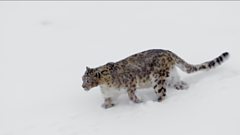Documentary series uncovering the secret lives of cats. In Ruaha, Tanzania, lions form huge super prides in order to hunt giants.
In Ruaha, Tanzania, lions form huge super prides in order to hunt giants. Amongst cats lions are unusual, the only one to live in groups. In numbers they find the strength and audacity to hunt the most formidable prey.
In Sri Lanka a tiny rusty-spotted cat explores his forest home - 200 times smaller than a lion, the rusty-spotted is the smallest of all cats, but just as curious.
The Canada lynx lives further north than any cat, relying on snowshoe hares to survive the bitterly cold winters. Until now, lynx were creatures of mystery, but now technology provides an insight
into their secret lives.
Predators they may be, but cats are also tender, intelligent and emotional. Honey is an African leopard and a mother. For a decade she's worn a radio collar that has allowed scientists to follow her life's every twist and turn. Now in the worst drought in decades, she's battling to raise a cub.
In the Himalayas, perhaps the world's most lonesome cat is searching for a mate - a male snow leopard, who may get just one chance to mate in his whole life.
Cats are naturally secretive, elusive and cryptic animals. Only now have the latest developments in filming technology, and a surge in cat research, enabled us to bring the cat superstars out of the shadows.
Last on
More episodes
Previous
You are at the first episode
Next
Clips
-
![]()
How to film a sprinting cheetah
Duration: 01:54
-
![]()
The world's smallest cat
Duration: 01:55
-
![]()
Kitten playtime
Duration: 01:43
-
![]()
Snow leopard lonely heart
Duration: 02:24
Credits
| Role | Contributor |
|---|---|
| Narrator | Bertie Carvel |
| Executive Producer | Michael Gunton |
| Series Producer | Gavin Boyland |
| Production Manager | Stella Stylianos |
| Producer | Nick Easton |
Broadcasts
- Thu 11 Jan 2018 20:00ΒιΆΉΤΌΕΔ One except Wales & Wales HD
- Sun 14 Jan 2018 15:30
- Tue 23 Jan 2018 02:10
- Sat 22 Sep 2018 20:00
- Sun 23 Sep 2018 02:20
- Sat 4 Jul 2020 10:00ΒιΆΉΤΌΕΔ Two except Scotland
- Mon 27 Feb 2023 15:30ΒιΆΉΤΌΕΔ Two except Scotland
- Mon 14 Oct 2024 15:15ΒιΆΉΤΌΕΔ Two except Scotland
Featured in...
![]()
Wildlife
Compelling wildlife documentaries, featuring amazing animals and stunning landscapes
![]()
Animal Kingdom Warriors
Immerse yourself in the natural worldβs battlegrounds. Only the strongest survive.
![]()
All Creatures Great and Small
From miniature marvels to gentle giants.
Meet the cats
Find out more about the cats that appear in the series.
Filming big cats
Get insights into how the crew captured the scenes in Big Cats.
The global pet trade in wild cats
The dangers of the global pet trade to wild cats.
Why scientists use radio collars to study cats
Why scientists may use radio collars to study small wild cats.
Return of the βSpanish Tigerβ
There are few conservation stories as inspiring as the reintroduction of the Iberian lynx







